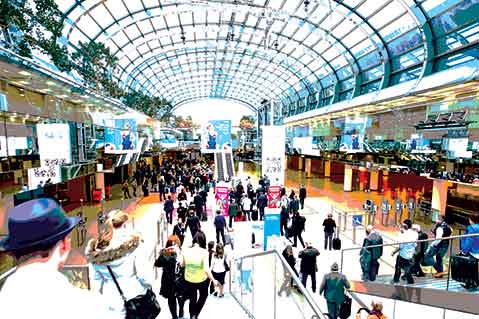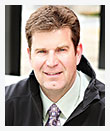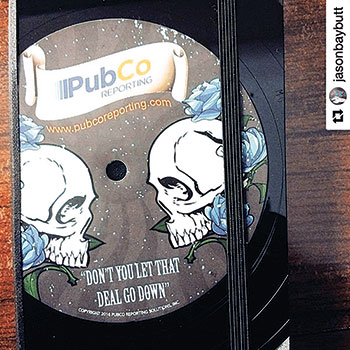Strategy January 13, 2017
Trade Show Tips for Promotional Product Pros
Use these tips to maximize your experience at the ASI Shows.
The ribbon has been cut, the confetti is now flying and the tightly packed crowd is rushing by you. Welcome to trade show season. No doubt, the whole scene can be equal parts intoxicating and overwhelming. There are thousands of products for you to peruse, dozens of networking events to stop into and a seemingly unlimited number of people and brands trying to get your attention.

If you’re attending a show for the first time, how can you ever begin to make sense of things? Well, as with everything in business and in life, it pays to have a plan – and some patience. Navigating trade shows takes time – they’re not a race to the finish line, and you can’t skim through stuff and expect great results.
“It always amazes me at the end of the first day when I hear someone say they are three-quarters of the way done with the show – that is simply not possible unless they’re motorcycling through,” says Lisa Pine, executive VP of sales at Axis Promotions (asi/128263).

One of Pine’s top trade show goals – which should be one of yours, too – is to learn as much as she can about products, current and new vendors, and understand the added value of what one factory can offer versus another. “They’re a lot of work, but these shows are the tools we use in our trade,” she says.
>>Don't Miss: Unique Ways to Network at A Trade Show
To help you along your trade show path, Advantages has polled industry and live events experts to gather their top tips. The result? We present a beginner’s trade show survival guide. So grab your most comfortable pair of shoes and let’s get going.
Set Basic Goals
Why are you attending a trade show, anyway? And what specifically do you want to accomplish? To be successful, these are questions you need to answer long before you step into a hotel or convention center.
“Typically, about 70% of attendees are there to see something new, such as new products and services,” says trade show consultant and coach Susan Friedmann. However, trade shows are also ideal for meeting new suppliers and service vendors, connecting with colleagues and attending education sessions.
If you can, try to set up appointments well in advance with suppliers you know you’d like to meet with. Don’t settle on approximate times, like after 3:00. Instead, agree to stop by a booth at 3:15. Then, come up with a specific goal for each vendor meeting. Maybe you want to know more about uniform sizes available within an apparel line or new decoration options available in 2017.
“At the first few trade shows I networked, I made the mistake of not setting specific goals for each meeting, and often found myself waffling when I was concluding the meeting,” says Jeff Kear, owner of Planning Pod, a provider of online event registration software for trade shows.
If you don’t have the chance to schedule appointments, you should at least scan the list of vendors when you arrive and then make a short list of those you want to meet face to face. “So much of my business is email. For me, the best part is meeting people in person,” says Rich Patterson, owner of Patterson Brands (asi/291582).
Depending on the size and length of the show, you should set realistic goals for how many contacts or connections you make on two levels: acquaintances and important follow-ups, says Emmi Buck, director of communications at Essential Oxygen, a maker of organic oral health products. Buck has attended over 40 trade shows in the past seven years, and organized even more than that.
“Ideally, out of all of the contacts made, a sales rep should aim to have 5%-10% of their contacts be the second level, more important high-quality connections that initiate an immediate and actionable follow-up and are strong leads,” she says.
Narrow down your focus. “Other than learning, who do you want to meet and why? This should tap into your greater business goals and professional development,” says Libby Gill, a leadership expert and executive coach.
Perhaps, for example, there’s someone in your industry that’s further along in their career that you want to meet and learn from. Gill believes having a cup of coffee with a friendly competitor is a great use of your trade show time.
In Pine’s case, even though she’s a trade show veteran, she still believes in asking suppliers lots of questions on the floor. For those firms she’s not super familiar with, she specifically wants to know: what added value they provide, what new services/decoration techniques they offer, what case studies they feature, and who are the key people at their company.

Plan Ahead
Some of the most important work in attending a trade show happens before ever setting foot in the venue. “All of the preparation should be done before arriving at the show,” says Buck.
When registering, review the list of exhibits and product galleries, which can be found either in the program or online, says Peter LoCascio, president of Trade Show Consultants.
Review the show’s list of educational outreach programs and zero in on what’s most important for your own goals. “There could be 100 different programs to choose from – you don’t want to do that on site,” says Friedmann.
Patterson attends trade shows on both sides of the aisle, as an exhibitor and attendee. When attending educational breakout sessions, he focuses on those that offer the newest advanced information or debate industry practices. He favors small breakout sessions that match his industry interests, such as on topics like new or cutting-edge decorating techniques. “I avoid ‘introduction to’ sessions that are too junior for my business.”
Another tip: Leverage social media before the show. Figure out who you want to connect with, and check out LinkedIn, Twitter and Facebook profiles. “Be a sleuth. Check out all attendee lists, know their backgrounds, interests, buying history and existing partnerships,” says Buck.
Gill thinks LinkedIn should be a pre-show go-to for every sales rep. “If a friend can make a connection with someone you want to get to know in advance of the show, it can allow you to contact that person ahead of time and let them know you will be at the show and looking to meet them there,” she says.
Attend Networking Events
Here are a couple of “musts” to add to your list: attend the opening reception and network at trade show workshops to connect with other industry professionals. “Introduce yourself, ask others what they have seen or what sessions have been particularly useful,” says Friedmann.
Depending on the conference or show, networking events could involve a golf tournament, hospitality suite, mixers in the exhibit hall, or social hours, as they provide a more relaxed place to strike up informal conversations, says Chris Piper, VP at Boundless (asi/143717). “These eventually lead into who you are, why you’re attending, and what you’re looking to gain from attending the show.”
How important is the social aspect of a show? Pine says very. This is “how you build your relationships: pre-show meetings, after-show drinks, dinners, smaller vendor meetings. Use as many of the hours of the show as you can,” she says.
Planning Pod’s Kear agrees. “Sometimes you find your best prospects in unexpected places, like an early morning exercise class or after-hours excursion or dinner, so fill up the gaps in your schedule with these types of activities to maximize every minute,” he says.
The best activities to attend at a trade show are those that allow you to talk to other people, and are fun and upbeat, like a walking tour, museum tour or wine tasting, says Gill. “In these situations, the experience is the icebreaker.”
Some events, though fun, can make networking a little trickier. For example, while music events can be fun, the noise makes it harder to network. “Have you ever given a successful sales pitch while trying to line dance next to somebody?” Buck asks.
Tips For Introverts
Are you a little shy? Don’t worry – you can still find success at trade shows. “Try to remember that everyone is nervous, even the keynote speakers,” says Emmi Buck, director of communications at Essential Oxygen. She suggests arriving early, and staying late, as it’s less noisy and crowded.
Libby Gill, an executive coach, recommends introverts have three basic questions in hand at all times so that “when the adrenaline pumps, they have something to start with.” Her suggestions: What business are you in? What are your favorite parts of the show? Where are you from? These are all good icebreakers.
Chris Piper, VP of Boundless (asi/143717), likes the idea of introverts pairing up with an extroverted colleague who enjoys asking questions and engaging people on the show floor.
Other options? Introverts should plan their trade show route to highlight the exhibitors they want to meet. Or they should email a person they’d like to meet with ahead of time and request a quieter place to get together. “This takes much of the stress away, because the introverted person doesn’t have to interrupt or wait in large groups,” Piper says.
Navigate Nimbly
When working a trade show, Gill uses the four points of the compass – north, south, east and west – to navigate the venue. It can keep you from getting lost.
Identify your “top 10” list of people you want to see and their booth numbers, and then go through your list sequentially, rather than making your way through randomly, suggests Friedmann.
If it’s a large show, Buck suggests having a map on your phone. “Always know where you are and where you’re going so there is no aimless wandering,” she says. Sometimes shows are so big, it’s easy to forget if you’ve already completed a section. In this case, use the map on your phone and “edit” the photo or take notes somewhere to mark areas you’ve completed, Buck says.
Successfully Follow Up
Keeping track of who you spoke with and what you discussed is essential to following up with prospects after a show. When introducing yourself, bring business cards, and if relevant, a small, cool, packable promo product that identifies you in a unique way, suggests Gill.
If you take someone else’s business card, make a short, simple note on the back to help facilitate follow-up later, Friedmann says. Also use your mobile devices for recording, taking pictures of people and business cards, as well as dictating short notes, she adds.
“Come back and share what you’ve accomplished – what you saw and how it relates to your business. Or you won’t be asked to attend the next one,” says LoCascio.
Axis’ Pine and her team put together a “Best of the Trade Show” email blast for all their clients to showcase what they’ve seen and learned. She take notes and staples business cards to them, and also uses a timeplanner journal from the show to document what she saw and who she needs to follow up with.
As you get to know suppliers, give extra time to those who invest in follow-up themselves. Pacific Sportswear & Emblem Co. (Pacsport), a maker of custom headwear, patches and accessories, often hands out specially designed embroidered patches at shows to win attention. Then, Pacsport president Rich Soergel marks business cards with a star if a prospect seems very interested for future follow-up. After the show, Soergel also sends emails to current and past customers waiving the setup charge to anyone that places a custom order within 30 days of the show. “We do that to incentivize prospects to jump on board,” he says.
Finally, Pacsport sends sample kits, containing three to five patches and a few other Pacsport products, to interested prospects. “Follow-up is key,” says Soergel.
Leave Room For Inspiration
 Rich Patterson, owner of Patterson Brands (asi/291582), typically uses a pattern when cruising trade shows, but he still leaves time to wander. “My clients are event and marketing companies, so what catches my attention are products and displays, like light-up items or wearable technology, that will appeal to them,” he says.
Rich Patterson, owner of Patterson Brands (asi/291582), typically uses a pattern when cruising trade shows, but he still leaves time to wander. “My clients are event and marketing companies, so what catches my attention are products and displays, like light-up items or wearable technology, that will appeal to them,” he says.
At a recent show, he spotted the booth of Vinylux, a company that recycles and transforms old vinyl LP records into cool new products. He stopped, met the owner and chatted for a while about his product line. When Patterson got back home to Vancouver, he got a call from a longtime client who needed promotional items for a Wall Street event, with a Grateful Dead theme.
Patterson immediately thought of Vinylux and recommended customized LP journals. “Within 60 days of the trade show, I had a signed purchase order, with solid margins, for 400 journals. It was a direct payoff for me,” says Patterson. “If I hadn’t turned that corner and spotted Vinylux, I would have missed a great opportunity. You don’t know what you don’t know – leave some time to just wander and be inspired.”
These events trigger ideas and inspiration, and always pay off, says Lisa Pine, executive VP of sales at Axis Promotions (asi/128263). “Trade shows are where suppliers put out the best of the best,” she says. Pine once spotted a graphic at a supplier’s booth and adapted it for one of her clients, ending up with a big order as a result.

Jean Erickson is a contributing writer for Advantages.
